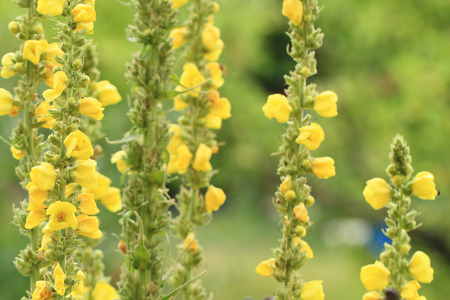Great Mullein - Verbascum densiflorum

Common Names: Great Mullein, mullein, King’s Candle, torch flower, torch plant, Candlewick plant, Shepherd’s Club Staff, Woolen, Adam’s Flannel, Verbascum densiflorum, Verbascum thapsus, Verbascum, Bouillon, Blanket Herb, Candleflower, Hag’s Taper, Duffle, High Taper, Longwort, Wild Ice Leaf, Velvet Plant, Torch Weed, Torches, Petrova Hůl, Divozel, Svíce Královská, Molène, Moléne Thapsus, Oreille de Loup, Gidar Tamaku, Gordolobo, Fleur de Grand Chandelier, Queue de Loup
Latin Name: Verbascum densiflorum
Origin: Asia, Europe, South America, North America
Short Introduction
Great Mullein thrives in poor, nutrient-deficient, and dry soils, especially those that are rocky or gravelly, which highlights its low-maintenance nature. When it comes to soil type, it prefers alkaline or neutral conditions. Adequate sunlight is crucial for optimal growth. The plant propagates easily by sowing seeds in the spring. For medicinal use, the bright yellow petals are harvested from May through September (they separate easily), though leaves or roots are sometimes used as well. To preserve the quality of the flowers, they should be dried thoroughly and quickly in the shade or using artificial heat up to 60°C, otherwise they may mold or spoil rapidly.
Detailed Description
“Indeed, this flower works wonders!”—so says a character from a folk tale who uses Great Mullein.
Botanical Information
Great Mullein is a sturdy, biennial herb that is covered in fine hairs and can grow up to 2 meters tall. In its first (vegetative) year, the plant forms a rosette of woolly, basal leaves. The following year, a straight stem emerges, bearing alternate, oval to lance-shaped leaves and bell-shaped calyxes with pale yellow corollas arranged in a terminal, branched cluster (appearing from May to September). The fruit is a capsule.
Origin and Distribution
Great Mullein is widespread throughout Europe, especially in central and southern regions. To the north, it reaches southern Sweden; to the east, it extends into central Russia, Georgia, and Azerbaijan. In the south, it is found in Spain, Portugal, Greece, and Italy. In the Czech Republic, Great Mullein is a very common and undemanding herb that thrives in neglected areas like wastelands, ditches, and dumps, as well as in gardens, meadows, rocky slopes, sunny parts of the countryside, and fields. Today, it is also found in Asia and the Americas.
Usage / Dosage
Beyond its medicinal use, Great Mullein has found wide and practical applications in other areas of daily life. Historically, its flowers were used to make candle wicks, and their dye to color hair or textiles. The leaves have been used to flavor foods (especially liqueurs) and to enhance the appearance of fruit tea blends. Folklore often references mullein, for instance, as an ingredient for invisibility in fairy tales, and as a “duchess” in poetry. Great Mullein is also an important pollen plant, providing a vital source of protein for bee colonies.
Medicinally, Great Mullein has been used for centuries to treat bronchial illnesses, upper respiratory tract inflammations, and colds. It is commonly used as a remedy for various types of cough and other respiratory conditions, including bronchial asthma. Mucilaginous substances in the plant form a protective coating on the mucous membranes of the upper respiratory tract, which helps protect tissues from irritation and drying out. Saponins and flavonoids in the plant can increase the secretion of bronchial epithelium and help dissolve mucus, making Great Mullein an excellent option for supporting respiratory tract health and maintaining a normal state of the respiratory system.
Additionally, Great Mullein’s constituents help relieve cramps, and herbalist J.A. Zentrich recommended the dried flowers (as an herbal medicine) for treating inflammatory diseases of the stomach and intestines, and in some cases for supporting liver, spleen, and gallbladder function, as well as for promoting urine production. Modern in vitro research has shown that the flower’s constituents may to some extent be able to relieve cramps. This supports claims that mullein helps maintain normal digestive function and aids in better digestion.
The anti-inflammatory and diuretic effects of Great Mullein’s constituents have been documented in smaller studies, aligning with its traditional use. Some compounds appear to stimulate urine production and promote the “cleansing” of the urinary tract, a process associated with partial disinfectant action. In cases where urination is hindered or problematic, regular intake of mullein flower constituents may support normal kidney and bladder function.
Externally, mullein is used for abrasions, venous ulcers, rheumatic pain, and hemorrhoids. To address these issues, poultices made from the flowers or decoctions of dried or fresh flowers are applied directly to swellings and inflamed areas. Flowers macerated in oil support wound healing.
Folk Medicine
Folk uses of Great Mullein include diuretic action, anti-inflammatory effects, as well as mucolytic and expectorant properties (supporting productive coughing). European folk medicine recommends Great Mullein for regulating and optimizing irregular menstrual cycles, relieving cramps during diarrhea, and cleansing the digestive and urogenital tracts. Austrian folk remedies mention its use for rhinitis, stuffy nose, and inflammation of the nasopharynx.
Active Compounds
Great Mullein flowers contain substantial amounts of saponins (verbascogenin, verbascosaponin), mucilaginous substances, tannins, iridoids (catalpol, aucubin), carotenoids, monoterpenoid glycosides, flavonoids (rutin, apigenin, luteolin, hesperidin, diosmin, tamarixetin), lignans, phenylethanol derivatives, as well as smaller amounts of essential oils, volatile oils, fatty acids, organic acids, and polysaccharides (such as galactose, arabinose, and uronic acids).
Traditional Dosage
Various parts of the plant are collected, but the flowers are most widely used. Sometimes leaves are used in addition to flowers in a 1:2 or 3:4 ratio and consumed as a mild laxative infusion. Flowers are used externally in a variety of preparations for the issues mentioned above. To make mullein tea: pour 250 ml of boiling water over one heaping tablespoon of the flowers, cover, and let steep until the tea cools to a suitable drinking temperature. For respiratory conditions, a bronchial tea blend including mullein, basil, linden, elder, mallow, thyme, or hyssop may be prepared.
